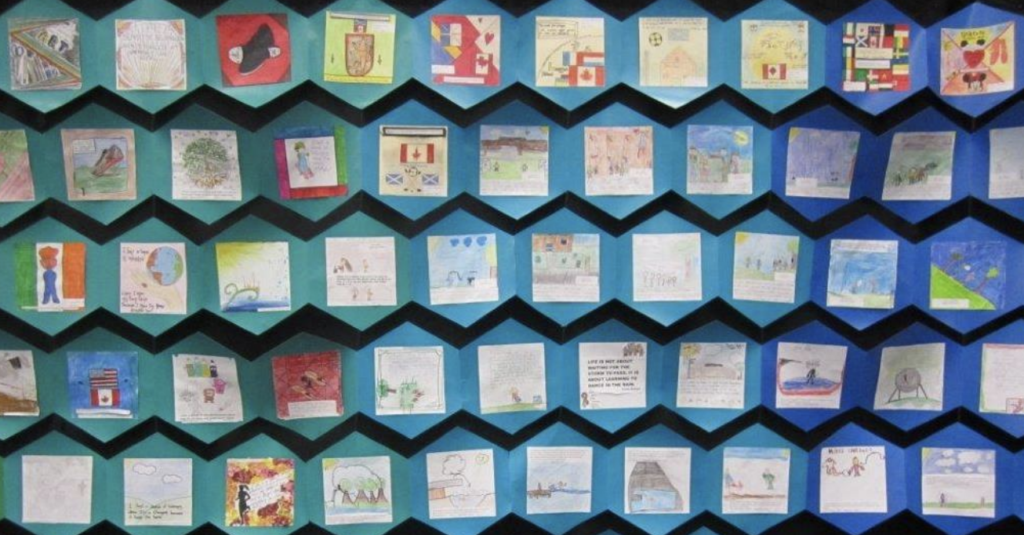Make your own Block for the Quilt of Belonging at Home and Show Us!
Our facility may be closed at the moment, and all of us are doing our best to keep the kiddo’s occupied while school is also closed. We wanted to remind you of the incredible FREE Educational Resources available with our current exhibition Quilt of Belonging.
Classrooms have been using this project to:
- foster a sense of belonging and pride in each student
- to teach inclusion and acceptance
- to celebrate diversity
- to learn about world cultures and First Peoples in Canada
- to foster harmony and a sense of pride in a school or classroom
Access More Free Resources for Quilt of Belonging Here.

Deadline for your Block Submission: Friday April 17th, 2020
Download full Learning Resource Guide Here for JK- Grade 6
This project can be made with a many materials and can comprise a wide range of ages. The example shown below was made with over 1,000 students from the Upper Canada District School Board, from Kindergarten to Grade 12. The Youth Quilt was over 100 feet long.
The project is adapted for different grade levels. It comes with instructions, a printable template, as well as guidelines for meeting the curriculum requirements in specific subject areas for each grade.

Use the Quilt Website to Explore the Quilt while the Exhibition is Closed
The actual Quilt of Belonging is a 120 foot (36 metres) long collaborative textile art project, a richly hued portrait of the human family. Its 263 blocks portray the rich cultural legacies of all the First Peoples in Canada and every nation of the world at the dawn of the new Millennium. Cultural profiles have been updated on-line to include all the countries of world at the present time.
The on-line Quilt is featured in Block-by-Block.

The Cultural Profile which follows includes some historical and geographical information and focuses on the cultural traditions of the nation—music, arts & crafts, cuisine, special celebrations. Most entries include beautiful photos and fascinating videos.
Before the Project:
Begin by doing any of the following:
- In Block-by-Block go to search and type in the country or aboriginal group you wish to study and follow the ‘links’
- In Block-by-Block go to search and type the subject or theme you are studying (e.g. celebrations, children, clothing, music, homes)
- In Block-by-Block go to the First Peoples index. How many of these nations do you know? Pick one you have never heard of before and go to that cultural profile and learn about it. Where are these people living? What language do they speak? Look at the photos and videos.
- Click on the Interactive world map and choose the area you are interested in. Then follow the ‘links’ to choose a country. Consider picking a nation that you know very little about or that is new to you.
- Study the continents. Click on the Interactive world map. How many countries are in Europe, Africa, Asia or South America? Which are in the Northern Hemisphere (above the equator)? Which are in the Southern Hemisphere (below the equator)? Pick a continent and click on the region index to find a list the countries in that continent.
- Discover our northern First Peoples in Canada by watching the informative video The Inuit of Canada produced by ITK (Inuit Tapiriit Kanatami)
Delivering the project.
These are suggestions. This project can be spread over several lessons.
- Ask children about the word ‘belonging’ and what it means.
- Explore some examples of how each of us can feel we belong.
- Use some of the additional activities to discuss this theme
- Children will look at Quilt of Belonging resources (Textiles Tell our Tales, Block-by-block, video, samples) choosing blocks they like and discovering who created them.
- Discuss how people are diverse: e.g. different foods, or celebrations etc. and children’s own experiences. Read and tell stories about children living in Canada and other parts of the world. 6. Children could bring in something from home that they think is special and there could be a display in the classroom.
Please Remember: We want to see your Blocks and we will be selecting one random winner from all the Submissions to take home a Quilt of Belonging Prize Package with a $50 value.
Post your Pictures on our Facebook Fanpage HERE.
We hope you have lots of fun with this at home project!













